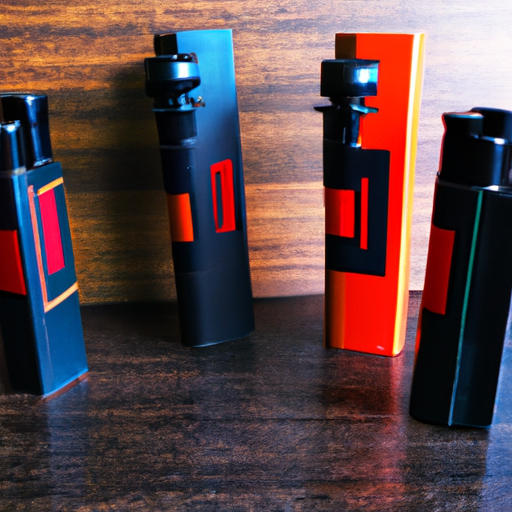“Precision and reliability start with the right gas block.”
Gas Block Materials: Steel vs. Aluminum
When it comes to choosing the right gas block for your rifle, one of the key decisions you’ll need to make is what material you want your gas block to be made from. The two most common options are steel and aluminum, each with its own set of advantages and disadvantages.
Steel gas blocks are known for their durability and strength. They can withstand high temperatures and pressures without deforming or breaking, making them a popular choice for many shooters. Steel gas blocks are also less likely to warp or corrode over time, ensuring that your rifle will continue to function reliably for years to come.
On the other hand, aluminum gas blocks are lighter in weight and more affordable than their steel counterparts. This can be advantageous if you’re looking to reduce the overall weight of your rifle or if you’re on a budget. However, aluminum is not as strong as steel and may not hold up as well under extreme conditions.
When deciding between steel and aluminum gas blocks, it’s important to consider how you’ll be using your rifle. If you plan on putting your rifle through rigorous use or exposing it to high temperatures, a steel gas block may be the better choice. However, if weight savings and cost are more important to you, an aluminum gas block could be the way to go.
Another factor to consider when choosing between steel and aluminum gas blocks is the type of ammunition you’ll be using. Some high-pressure rounds can put a significant amount of stress on a gas block, which may cause an aluminum block to fail where a steel block would hold up just fine. If you plan on shooting powerful rounds, it’s worth investing in a steel gas block for added peace of mind.
It’s also worth noting that some shooters prefer the aesthetics of a steel gas block over an aluminum one. Steel has a more rugged and industrial look that some find appealing, while aluminum has a more modern and sleek appearance. Ultimately, the choice between steel and aluminum gas blocks will come down to personal preference and what factors are most important to you.
In conclusion, when choosing the right gas block for your rifle, the decision between steel and aluminum comes down to a balance of durability, weight, cost, and aesthetics. Consider how you’ll be using your rifle, what type of ammunition you’ll be shooting, and what look you prefer before making your final decision. Both steel and aluminum gas blocks have their own set of advantages and disadvantages, so weigh your options carefully before making a purchase. With the right gas block in place, your rifle will perform reliably and accurately for years to come.
Adjustable vs. Non-Adjustable Gas Blocks
Gas blocks are a crucial component of any rifle’s gas system, as they regulate the flow of gas from the barrel to cycle the action. When it comes to selecting a gas block for your rifle, one of the key decisions you’ll need to make is whether to go with an adjustable or non-adjustable option.
Non-adjustable gas blocks are the simpler of the two options, as they have a fixed gas port size that is designed to work with a specific type of ammunition and barrel length. This means that once you install a non-adjustable gas block on your rifle, there’s no need to make any further adjustments – you can simply load up your ammo and start shooting.
On the other hand, adjustable gas blocks give you the ability to fine-tune the amount of gas that is being directed back into the action. This can be particularly useful if you’re using a suppressor or shooting different types of ammunition, as it allows you to optimize your rifle’s performance for each specific scenario.
One of the main advantages of adjustable gas blocks is their versatility. By being able to adjust the gas flow, you can ensure that your rifle functions reliably in a variety of conditions. For example, if you’re shooting in cold weather or at high altitudes, you can open up the gas block to allow for more gas flow and prevent malfunctions.
Another benefit of adjustable gas blocks is their ability to reduce recoil and muzzle rise. By tuning the gas flow to just the right amount, you can minimize the amount of energy transferred back into the action, resulting in a smoother shooting experience and faster follow-up shots.
However, it’s important to note that adjustable gas blocks can be more complex to install and tune compared to non-adjustable options. You’ll need to carefully follow the manufacturer’s instructions and possibly make several adjustments before finding the optimal setting for your rifle.
When deciding between adjustable and non-adjustable gas blocks, consider your level of experience with firearms and how much time you’re willing to dedicate to tuning your rifle. If you’re a beginner or simply want a set-it-and-forget-it solution, a non-adjustable gas block may be the way to go.
On the other hand, if you’re comfortable with tinkering and want to get the most out of your rifle’s performance, an adjustable gas block could be worth the extra effort. Just be prepared to spend some time at the range testing different settings and making adjustments until you find what works best for your specific setup.
Ultimately, whether you choose an adjustable or non-adjustable gas block will depend on your individual needs and preferences. Both options have their pros and cons, so take the time to weigh them carefully before making a decision. Whichever route you go, having a properly functioning gas block is essential for ensuring your rifle performs reliably and accurately every time you pull the trigger.
Low-Profile vs. Picatinny Gas Blocks

When it comes to upgrading or customizing your rifle, one of the key components to consider is the gas block. The gas block plays a crucial role in regulating the flow of gas from the barrel to cycle the action of the rifle. This not only affects the performance and reliability of your rifle but also impacts its overall aesthetics. In this article, we will discuss two popular types of gas blocks: low-profile and Picatinny gas blocks, and help you determine which one is the right choice for your rifle.
Low-profile gas blocks are designed to sit close to the barrel, minimizing interference with handguards and other accessories. They are often used in conjunction with free-floating handguards to maintain a sleek and streamlined profile. Low-profile gas blocks are available in a variety of materials, including steel, aluminum, and titanium. Steel gas blocks are durable and offer excellent heat resistance, making them a popular choice for high-temperature applications. Aluminum gas blocks are lightweight and corrosion-resistant, making them ideal for lightweight builds. Titanium gas blocks offer a good balance of strength and weight savings but come at a higher price point.
On the other hand, Picatinny gas blocks feature a Picatinny rail on top, allowing for easy attachment of accessories such as iron sights, red dot sights, or lasers. This added versatility makes Picatinny gas blocks a popular choice for tactical or competition rifles where customization options are important. However, it is important to note that the added height of the Picatinny rail may interfere with some handguards or optic mounts, so careful consideration should be taken when choosing this type of gas block.
When deciding between a low-profile and Picatinny gas block, there are several factors to consider. If you prioritize a clean and minimalist look for your rifle, a low-profile gas block may be the way to go. On the other hand, if you want the flexibility to easily attach accessories without additional mounting hardware, a Picatinny gas block may be more suitable for your needs.
It is also important to consider the material and construction of the gas block. Steel gas blocks offer durability and heat resistance but may add weight to your rifle. Aluminum gas blocks provide a lightweight option but may not be as robust as steel counterparts. Titanium gas blocks offer strength and weight savings but come at a higher cost.
Another factor to consider is installation. Low-profile gas blocks typically require dimpling or pinning of the barrel for proper alignment, while Picatinny gas blocks can be easily attached using screws or clamps. If you are comfortable with more involved installation processes, a low-profile gas block may be a good option. However, if you prefer a simpler installation method, a Picatinny gas block may be more suitable for your needs.
In conclusion, choosing the right gas block for your rifle ultimately comes down to personal preference and intended use. Whether you opt for a low-profile or Picatinny gas block, make sure to consider factors such as material, construction, installation method, and compatibility with other accessories. By carefully weighing these considerations, you can select a gas block that enhances both the performance and aesthetics of your rifle.
Gas Block Diameters: .750 vs. .625
Gas blocks are a crucial component of any rifle, as they regulate the flow of gas from the barrel to cycle the action. When it comes to choosing the right gas block for your rifle, one important consideration is the diameter of the gas block. Gas blocks typically come in two standard sizes: .750 and .625 inches.
The .750 gas block is the larger of the two options and is commonly found on AR-15 rifles and other modern sporting rifles. This size provides a more secure fit on the barrel and can handle higher pressures, making it ideal for larger caliber rifles or those with longer barrels. The .750 gas block is also more versatile, as it can accommodate a wider range of barrel profiles and gas tube sizes.
On the other hand, the .625 gas block is smaller in diameter and is often used on lightweight or competition rifles where reducing weight is a priority. This size is more commonly found on rifles chambered in .223/5.56mm and other smaller calibers. The .625 gas block is also preferred by some shooters for its sleeker profile and potential for improved accuracy.
When deciding between a .750 and .625 gas block for your rifle, it’s important to consider the intended use of the rifle. If you plan on shooting larger calibers or using a longer barrel, a .750 gas block may be the better choice for its increased strength and compatibility with a wider range of components. However, if weight savings and precision shooting are your priorities, a .625 gas block may be more suitable.
Another factor to consider when choosing a gas block diameter is the availability of aftermarket parts and accessories. While both .750 and .625 gas blocks are widely available, some manufacturers may offer more options for one size over the other. It’s important to ensure that your chosen gas block size is compatible with your barrel, gas tube, and handguard to avoid any compatibility issues down the line.
In addition to diameter, there are other factors to consider when selecting a gas block for your rifle. Material choice, finish, and installation method are all important considerations that can affect the performance and longevity of your rifle. Stainless steel and aluminum are common materials used in gas blocks, each offering their own advantages in terms of durability and weight.
When it comes to finishes, nitride, phosphate, and cerakote are popular options that provide corrosion resistance and enhance the appearance of your rifle. As for installation method, clamp-on, set screw, and pinning are common techniques used to secure the gas block to the barrel. Each method has its own pros and cons in terms of ease of installation and reliability.
Ultimately, choosing the right gas block for your rifle comes down to personal preference and intended use. Whether you opt for a .750 or .625 gas block, it’s important to select a high-quality component that will provide reliable performance for years to come. By considering factors such as diameter, material choice, finish, and installation method, you can ensure that your rifle is equipped with the best possible gas block for your needs.
Piston vs. Direct Impingement Gas Systems
When it comes to choosing the right gas block for your rifle, one of the key decisions you’ll need to make is whether to go with a piston or direct impingement gas system. Both systems have their own set of pros and cons, so it’s important to understand the differences between them before making a decision.
Direct impingement gas systems are the more traditional option, and are found in many AR-15 rifles. In a direct impingement system, gas from the fired round is directed back into the rifle’s chamber to cycle the action. This system is relatively simple and lightweight, making it a popular choice among shooters who value simplicity and reliability.
On the other hand, piston gas systems work by using a piston to drive the bolt carrier group instead of directing gas back into the chamber. This can result in cleaner operation and less fouling in the rifle’s action, which can lead to improved reliability and easier maintenance. However, piston systems are typically heavier and more complex than direct impingement systems.
One of the main advantages of direct impingement systems is their simplicity. Because there are fewer moving parts involved in cycling the action, direct impingement rifles tend to be lighter and more maneuverable than their piston-driven counterparts. This can be especially important for shooters who need to carry their rifle over long distances or through rough terrain.
However, one of the downsides of direct impingement systems is that they can be prone to fouling. Because gas is directed back into the chamber during each shot, carbon buildup can occur over time, which can affect the rifle’s reliability and accuracy. Regular cleaning and maintenance are essential for keeping a direct impingement rifle running smoothly.
Piston systems, on the other hand, are known for their cleaner operation. Because gas is not directed back into the chamber, there is less carbon buildup in the action, which can lead to improved reliability and easier maintenance. Piston-driven rifles are also less affected by changes in barrel length or ammunition type, making them a versatile option for shooters who like to experiment with different setups.
However, one of the drawbacks of piston systems is their added weight and complexity. The additional components required for a piston-driven system can make the rifle heavier and bulkier than a direct impingement rifle. This can be a concern for shooters who prioritize lightweight and maneuverability in their firearms.
Ultimately, the choice between a piston or direct impingement gas system will depend on your individual preferences and shooting needs. If you value simplicity and lightweight design, a direct impingement system may be the best option for you. On the other hand, if you prioritize reliability and ease of maintenance, a piston-driven system may be worth considering.
Regardless of which system you choose, it’s important to do your research and consider factors such as weight, reliability, maintenance requirements, and compatibility with your existing rifle setup. By taking the time to weigh these considerations carefully, you can ensure that you choose the right gas block for your rifle that will meet your needs and preferences for years to come.







